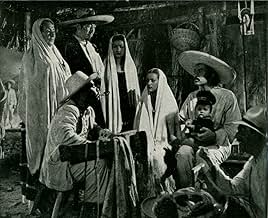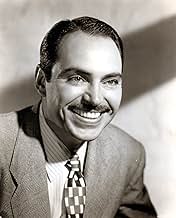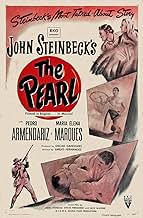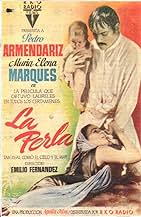NOTE IMDb
7,4/10
1,2 k
MA NOTE
La découverte d'une énorme perle change à jamais la vie d'un pauvre pêcheur mexicain et de sa famille. Mais la nouvelle se répand et éveille les convoitisesLa découverte d'une énorme perle change à jamais la vie d'un pauvre pêcheur mexicain et de sa famille. Mais la nouvelle se répand et éveille les convoitisesLa découverte d'une énorme perle change à jamais la vie d'un pauvre pêcheur mexicain et de sa famille. Mais la nouvelle se répand et éveille les convoitises
- Réalisation
- Scénario
- Casting principal
- Récompenses
- 9 victoires et 6 nominations au total
José Arratia
- Tratante de perlas
- (non crédité)
Guillermo Calles
- Indio rastreador
- (non crédité)
Enrique Cancino
- Pueblerino
- (non crédité)
Maria Elena Cuadros
- Juanita
- (non crédité)
Columba Domínguez
- Pueblerina
- (non crédité)
Enedina Díaz de León
- Yerbera
- (non crédité)
Agustín Fernández
- Pueblerino
- (non crédité)
Rogelio Fernández
- Pueblerino
- (non crédité)
Raquel García
- Pueblerina
- (non crédité)
Avis à la une
This is a wonderfully shot film whose story, while not totally believable, could serve as allegory. Perhaps the family of the Mexican fisherman-diver played by Armendariz would have been happier if he had not discovered the pearl at all, but the poverty that endangers their baby's life makes his joy at this discovery (in a good underwater scene) credible. Immediately afterward, he finds himself beset by freeloaders and robbers (including his own brother), and the spiral continues until it ends in flight, hunger, death and a sort of redemption: the pearl is hurled back into the sea that spawned it. Apart from the story, the highlight is the Mexican scenery, the village and villagers, and the skillful and evocative camera angles. As one reviewer wrote, it's unlikely a villagers' celebration would have been as elaborate as the one shown in "La Perla," but it is enjoyable. Perhaps one semi-cynical message that could be gained from this film is that if you strike it rich, tell as few people as possible.
10whpratt1
Some how I over looked this John Steinbeck brief story years ago and loved this 1947 production and the fantastic acting. The film is great in black and white and it clearly shows the poverty of local fishermen and their hard tasks of having to dive only when the ocean was calm. Pedro Armendariz,"From Russia With Love",'63 and Maria Elena Marques,"Pueblilo",'62, gave an outstanding performance as husband and wife who have to deal with finding a great treasure and having to face the hard facts of many people who want to share their wealth. Charles Rooner,(Doctor),"Silent Fear",'56 plays a very horrible doctor who seems to hate the local fishermen and wants to treat only the rich who will be able to pay his medical fees. This is truly a great film, which was very well produced and a great Film Classic from the late 40's. Enjoy
Making an adaptation off John Steinbeck's short novel wasn't easy and always a feat.But Emilio Fernandez and Gabriel Figueroa did it in a succesful way.
Pedro Armendariz repeats on a high class of acting role as in 'Maria Candelaria'. Once again the cinematography of Gabriel Figueroa ranks among the best he's done. (the cinematography of this movie earned him, a prize at the Cannes Film Festival).
The aid of Mr. Steinbeck himself, helped Emilio to adapt the screenplay just as good as the novel itself.
This movie has no flaws and it ranks among the best in Mexico Film History, a must see.
Pedro Armendariz repeats on a high class of acting role as in 'Maria Candelaria'. Once again the cinematography of Gabriel Figueroa ranks among the best he's done. (the cinematography of this movie earned him, a prize at the Cannes Film Festival).
The aid of Mr. Steinbeck himself, helped Emilio to adapt the screenplay just as good as the novel itself.
This movie has no flaws and it ranks among the best in Mexico Film History, a must see.
10jotix100
"La Perla", the magnificent 1947 film directed by Emilio "El Indio" Fernandez is a testament to his genius. With the help of one of the greatest cinematographers the world has ever known, Gabriel Figueroa, we are treated to a tale of hope and greed set in the Pacific coast of Mexico. Based loosely on John Steinbeck's story, the author himself, helped enhance his own story with the screen treatment.
We are introduced to Quino and Juana and their infant son, living in poverty. They are starving because the seas have been too turbulent to go pearl fishing. They almost lose the boy that is bitten by a scorpion and the village doctor refuses to take care of the infant since they have no money. The village women nurse him back to health.
When Quino and Juana go fishing, he discovers a large and shiny pearl. This pearl will be their undoing. Quino is hoping for a better life for the boy, so that he doesn't have to lead their precarious life. Fate, on the other hand, intervenes as the beautiful pearl becomes the object of desire for the ruthless dealers, and the doctor, who want to steal it from Quino.
They end up fleeing their village. In a sequence that is as cruel, as it is beautiful, we see the fishers being pursued by the dealer and his Indian searchers, and the doctor through the mangroves first, and the arid countryside later on. Unfortunately, Quino and Juana are robbed of something more precious than the magnificent pearl that has been the object of their downfall.
Mr. Figueroa's cinematography feasts on the magnificent views of the region. The film looks as good today with the excellent copy that must have been restored because it has a pristine quality. Of course, nothing would have been possible with another director because Emilio Fernandez understood the people and was able to present his story in pure cinematic terms.
Pedro Armendariz, as Quino, makes one of the best appearances of his distinguished film career. He was an actor that clearly knew his subject and understood the man he was portraying. Maria Elena Marques is right as Juana, the caring woman and mother. Mr. Armendariz and Ms. Marques gave more than life to this couple.
What seems hard to understand was the casting of Charles Rooner as the evil doctor, or Fernando Wagner, as the crooked dealer, for that matter. Both speak Spanish with a heavy French accent, something that doesn't feel right, but maybe, on the other hand, the director and the writers felt that by having foreigners try to cheat Quino and Juana set the right tone for the story.
Also, the insertion of the fiesta sequence, while lovely to look at, it seems something right out of the Ballet Folklorico and too elaborate for the conditions in which most of the fishermen lived! It's nice to have heard a stylized version of La Bamba, but somehow, it distracts from reality.
"La Perla" was a monumental achievement thanks to Mr. Fernandez's and Mr. Figueroa's inspired take on the Steinbeck story.
We are introduced to Quino and Juana and their infant son, living in poverty. They are starving because the seas have been too turbulent to go pearl fishing. They almost lose the boy that is bitten by a scorpion and the village doctor refuses to take care of the infant since they have no money. The village women nurse him back to health.
When Quino and Juana go fishing, he discovers a large and shiny pearl. This pearl will be their undoing. Quino is hoping for a better life for the boy, so that he doesn't have to lead their precarious life. Fate, on the other hand, intervenes as the beautiful pearl becomes the object of desire for the ruthless dealers, and the doctor, who want to steal it from Quino.
They end up fleeing their village. In a sequence that is as cruel, as it is beautiful, we see the fishers being pursued by the dealer and his Indian searchers, and the doctor through the mangroves first, and the arid countryside later on. Unfortunately, Quino and Juana are robbed of something more precious than the magnificent pearl that has been the object of their downfall.
Mr. Figueroa's cinematography feasts on the magnificent views of the region. The film looks as good today with the excellent copy that must have been restored because it has a pristine quality. Of course, nothing would have been possible with another director because Emilio Fernandez understood the people and was able to present his story in pure cinematic terms.
Pedro Armendariz, as Quino, makes one of the best appearances of his distinguished film career. He was an actor that clearly knew his subject and understood the man he was portraying. Maria Elena Marques is right as Juana, the caring woman and mother. Mr. Armendariz and Ms. Marques gave more than life to this couple.
What seems hard to understand was the casting of Charles Rooner as the evil doctor, or Fernando Wagner, as the crooked dealer, for that matter. Both speak Spanish with a heavy French accent, something that doesn't feel right, but maybe, on the other hand, the director and the writers felt that by having foreigners try to cheat Quino and Juana set the right tone for the story.
Also, the insertion of the fiesta sequence, while lovely to look at, it seems something right out of the Ballet Folklorico and too elaborate for the conditions in which most of the fishermen lived! It's nice to have heard a stylized version of La Bamba, but somehow, it distracts from reality.
"La Perla" was a monumental achievement thanks to Mr. Fernandez's and Mr. Figueroa's inspired take on the Steinbeck story.
The Pearl is directed by Emilio Fernández and John Steinbeck co-adapts his own novella of the same name with Fernández and Jack Wagner. It stars Pedro Armendariz, María Elena Marqués, Fernando Wagner, Gilberto González, Juan García and Charles Rooner. Music is by Antonio Díaz Conde and cinematography by Gabriel Figueroa.
We are in La Paz, Mexico, and when Quino and Juana's son is stung by a scorpion the couple are anguished by not having the finances to pay for medical treatment. Hope springs eternal when Quino discovers a large pearl, something which is seemingly the answer to their prayers - is it?
What we basically have here is a morality play about the corruption of greed. Once the pearl of the title is discovered the ugliness of mankind rears its vile head. People around Quino and Juana - a homely honest but poor couple - suddenly have designs on the financial gains that the pearl can bring - with some of them willing to commit cardinal sins to achieve their aim. The pearl also begins to drive a wedge between the loving couple, and thus we are held enthral of the story to see exactly where this will all end up?
Though it's not very subtle in the telling, with Steinbeck's literary bent often as heavy as a sledgehammer, this is undeniably compelling stuff. That it's also a visual delight also considerably aids the viewing experience. Fernández and Figueroa bring truly atmospheric cinematography into play as a key character of the piece, with kinked frames and low level shots perfectly embracing the discord of the troubling human conditioning on view. Come 1947 what we would come to know as the film noir style of film making was in full effect, fans of such should for sure add The Pearl to their must seek out lists. 8/10
We are in La Paz, Mexico, and when Quino and Juana's son is stung by a scorpion the couple are anguished by not having the finances to pay for medical treatment. Hope springs eternal when Quino discovers a large pearl, something which is seemingly the answer to their prayers - is it?
What we basically have here is a morality play about the corruption of greed. Once the pearl of the title is discovered the ugliness of mankind rears its vile head. People around Quino and Juana - a homely honest but poor couple - suddenly have designs on the financial gains that the pearl can bring - with some of them willing to commit cardinal sins to achieve their aim. The pearl also begins to drive a wedge between the loving couple, and thus we are held enthral of the story to see exactly where this will all end up?
Though it's not very subtle in the telling, with Steinbeck's literary bent often as heavy as a sledgehammer, this is undeniably compelling stuff. That it's also a visual delight also considerably aids the viewing experience. Fernández and Figueroa bring truly atmospheric cinematography into play as a key character of the piece, with kinked frames and low level shots perfectly embracing the discord of the troubling human conditioning on view. Come 1947 what we would come to know as the film noir style of film making was in full effect, fans of such should for sure add The Pearl to their must seek out lists. 8/10
Le saviez-vous
- AnecdotesEmilio Fernández, who was in love with Olivia de Havilland, thought she was the ideal actress to play the female starring role. De Havilland never knew of his secret love, but the director was able to get the government of Mexico City to change the name of the street he grew up on to "Dulce Olivia" (Sweet Olivia).
- Citations
Narrator: This is a story that old men tell to children. They aren't sure where it happened or when.
- Versions alternativesA short version (77') was shown in the USA, France and West Germany whereas a longer version (85 to 87') was shown in Mexico and East Germany.
- ConnexionsAlternate-language version of The Pearl (1948)
Meilleurs choix
Connectez-vous pour évaluer et suivre la liste de favoris afin de recevoir des recommandations personnalisées
- How long is The Pearl?Alimenté par Alexa
Détails
- Durée1 heure 25 minutes
- Couleur
- Rapport de forme
- 1.37 : 1
Contribuer à cette page
Suggérer une modification ou ajouter du contenu manquant

























